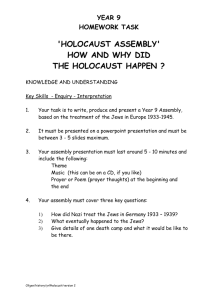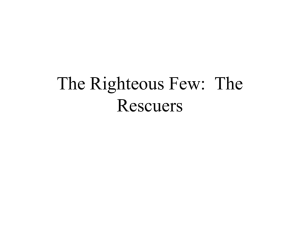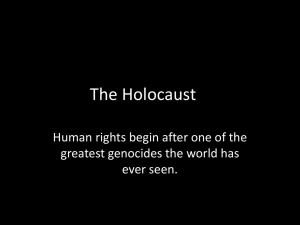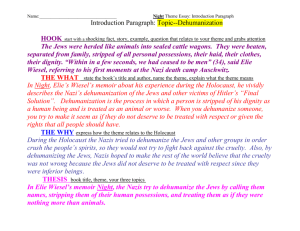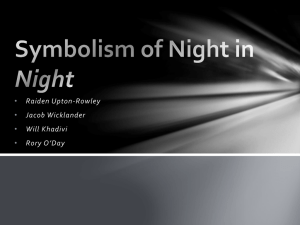YEAR 10 Christmas Exam REVISION NOTES
advertisement
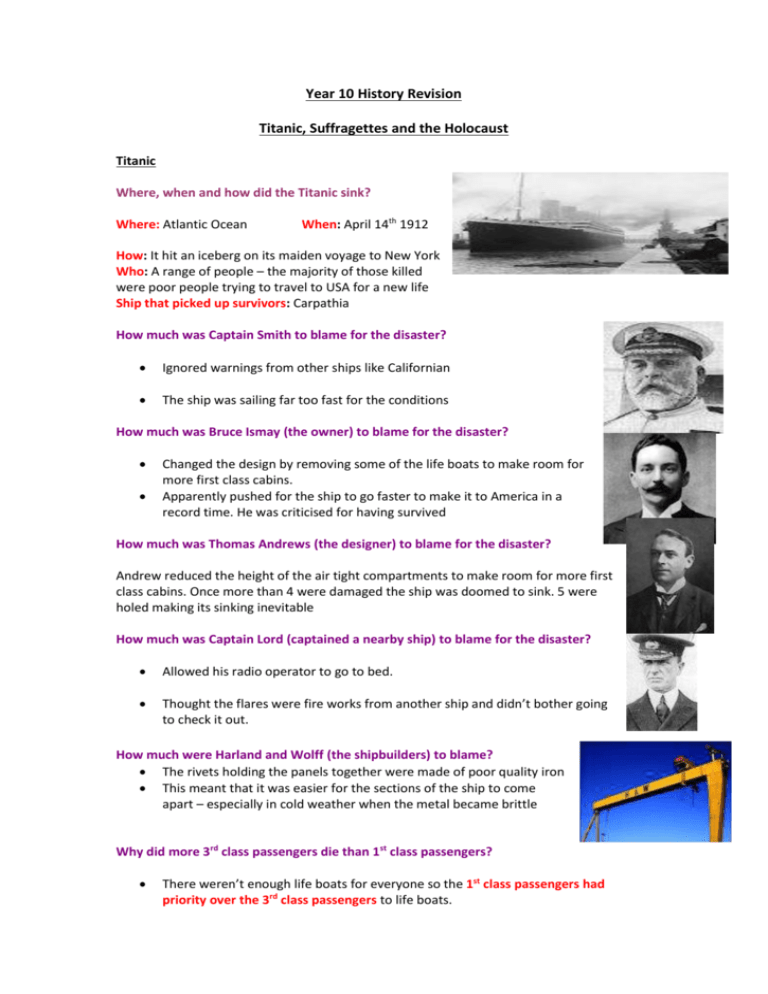
Year 10 History Revision Titanic, Suffragettes and the Holocaust Titanic Where, when and how did the Titanic sink? Where: Atlantic Ocean When: April 14th 1912 How: It hit an iceberg on its maiden voyage to New York Who: A range of people – the majority of those killed were poor people trying to travel to USA for a new life Ship that picked up survivors: Carpathia How much was Captain Smith to blame for the disaster? Ignored warnings from other ships like Californian The ship was sailing far too fast for the conditions How much was Bruce Ismay (the owner) to blame for the disaster? Changed the design by removing some of the life boats to make room for more first class cabins. Apparently pushed for the ship to go faster to make it to America in a record time. He was criticised for having survived How much was Thomas Andrews (the designer) to blame for the disaster? Andrew reduced the height of the air tight compartments to make room for more first class cabins. Once more than 4 were damaged the ship was doomed to sink. 5 were holed making its sinking inevitable How much was Captain Lord (captained a nearby ship) to blame for the disaster? Allowed his radio operator to go to bed. Thought the flares were fire works from another ship and didn’t bother going to check it out. How much were Harland and Wolff (the shipbuilders) to blame? The rivets holding the panels together were made of poor quality iron This meant that it was easier for the sections of the ship to come apart – especially in cold weather when the metal became brittle Why did more 3rd class passengers die than 1st class passengers? There weren’t enough life boats for everyone so the 1st class passengers had priority over the 3rd class passengers to life boats. THE SUFFRAGE MOVEMENT What is meant by the term ‘suffrage’? The right to vote in a political election. Suffragist – Protested peacefully – Led by Millicent Fawcett Suffragette – Protested with violence- Led by Sylvia Pankhurst Slogan of suffragettes. Deeds not words Name some of the leading Suffragettes. Emmeline Pankhurst Emily Davison Sylvia Pankhurst What actions did the Suffragettes take to try to gain the vote? Chained themselves to railings. Smashed parliament’s windows. Attacked members of parliament. Pelted the politicians with eggs. Emily Davidson threw herself at the King’s horse during the 1913 Derby. Why were some people against giving women the right to vote? Women were classed as lower rank in society. Women would not be able to cope with making decisions in parliament, they are too emotional. Women should stay at home to cook, clean and have children. How were the Suffragettes treated in prison? Hunger strikers were force fed. Prisoners were released and rearrested after they ate. This was called the CAT AND MOUSE ACT. Why did the Suffragettes suspend their campaign at the start of World War 1? To help with the war, as the men were leaving to go to war the women needed to do their jobs. Women became: bus drivers and police officers. When did women finally get the right to vote on the same basis as men? In 1918 women over the age of 30 got the right to vote.(If they owned a house) It took until 1928, for women to have the same voting rights as men – all men and women over 21 could then vote, even if they were not married. THE HOLOCAUST What was meant by the following terms? Holocaust: A name for the Nazis’ attempt to wipe out the Jewish race. Genocide: Deliberate extermination of the race of people. Anti-Semitism: Prejudice and discrimination against Jews Persecution: The regular mistreatment of one group by another group. Indoctrination: “brain-washed” into thinking in a particular way. Ghetto: Separate areas on the edge of cities where Jews were forced to live. There was vast overcrowding and the Jews lived in terrible poverty. Many died of starvation and disease. Why did Hitler and the Nazis hate Jews? There was a history of hatred towards the Jews because many Early Christians blamed the Jews for the crucifixion of Jesus. Also, in the 12th century, many believed the untrue rumour that the Jews murdered Christian children as part of their religious beliefs. The Nazis believed that their race, the Aryan race, was more superior (better) than the Jews. Hitler blamed the Jews for Germany’s defeat in the First World War and all Germanys problems – They were a scapegoat. The Nazis didn’t think the Jews were “proper” Germans, as they spoke their own language and practised a different religion. What was the experience of Jews in Nazi Germany in the 1930’s? In 1933-5, the Nazis began to pass Anti-Semitic laws (NUREMBERG LAWS). These included: Boycott Jewish businesses Banning marriage between Jews and non-Jews Stopped Jews from being German citizens Stopped them from using cinemas and swimming pools Jewish children could not go to German schools. In 1938, Nazi leaders destroyed Jewish businesses and synagogues, and arrested Jewish men and sent them to concentration camps. This was known as the Night of Broken Glass. How did the experience of Jew change once war broke out in 1939? Western European Jews (i.e. in France, and Holland) could emigrate to the USA if they were American or married to an American. Eastern European Jews were moved into slums in cities such as Warsaw, Poland. These were sealed off by walls and guards. These areas were known as ghettos. Disease and starvation was common in the ghettos, and many Jews died because of the appalling living conditions. In 1941, the Nazis began their “Final Solution”. The Jews were arrested and transported to various concentration camps across Europe. Those who were fit were spared to work, building factories and barracks. Many others were killed on arrival. Describe what happened to Jews in Nazi concentration camps? On arrival, they were split into two groups: Those who were fit and able were put to work. They made weapons, and built factories and barracks. When they became too weak to work, they were killed and replaced by new “work-Jews.” The old, the sick, women and their young children, and pregnant women were killed in gas chambers. They were fed small amounts of bread and coffee for breakfast and potato and turnip soup for dinner. This led to them basically starving. Many dies of diseases like typhus. They wore thin, rough uniforms and had to sleep in cold barracks, on hard wooden bunks. Most did not survive longer than 3 months in the camp. Why did Allies not try and stop the Holocaust? The leaders of the Allies did not see the Jews suffering as a priority. The priority was defeating Germany, which they believed would then save the Jews. Camps like Auschwitz (in Poland) was too far away to bomb or invade until 1944 and many prisoners would have died in such attacks anyway.




